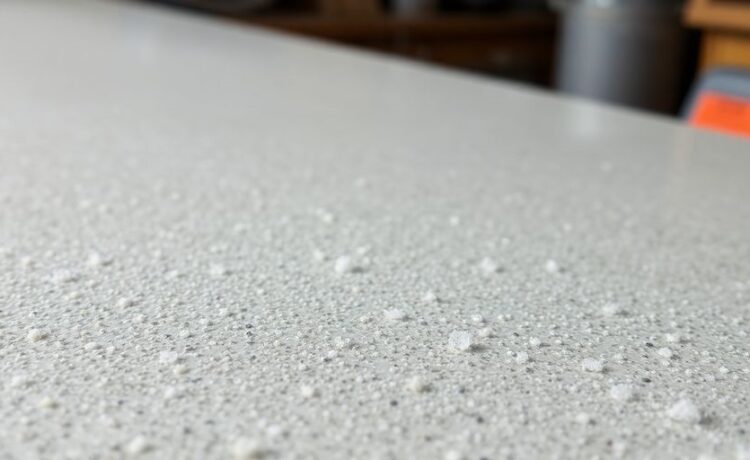What is Silicosis?
Silicosis is a serious lung disease caused by inhaling tiny particles of silica, a mineral found in sand, quartz, and many other types of rock. When workers breathe in silica dust, it can lead to inflammation and scarring in the lungs, making it difficult to breathe over time. The disease is progressive, meaning it worsens over time, and symptoms may not appear until years after exposure. In severe cases, silicosis can be disabling or even fatal.
Health Risks Associated with Silica Dust
Exposure to silica dust doesn’t just cause silicosis; it can lead to a host of other health issues. Workers exposed to silica may develop chronic obstructive pulmonary disease (COPD), lung cancer, and kidney disease. Symptoms of silicosis often include a persistent cough, chest pain, and shortness of breath. Fatigue and weight loss are also common. Because these symptoms can take years to manifest, regular medical check-ups are crucial for those working in high-risk environments.
Statistics on Silicosis in the Countertop Industry
The countertop industry, particularly those working with engineered stone, has seen a disturbing rise in silicosis cases. Countertop workers are increasingly at risk, as highlighted in a recent study. Engineered stone, which can contain up to 90% silica, poses a significant threat. A 2023 study revealed that 40% of workers exposed to silica dust in this industry had developed advanced silicosis, with 19% succumbing to the disease. The median age of diagnosis is alarmingly young at 45, underscoring the urgent need for better protective measures and awareness in the industry.
Legal Grounds for Filing a Countertop Silicosis Lawsuit
Eligibility Criteria for a Silicosis Lawsuit
To determine if one can file a silicosis lawsuit, certain criteria must be met. Firstly, there must be evidence of exposure to silica dust in the workplace. This exposure often occurs in industries like countertop fabrication, where workers are frequently in contact with engineered stone. Secondly, a diagnosis of silicosis or a related health condition, such as lung cancer or chronic obstructive pulmonary disease (COPD), should be confirmed by a healthcare professional. Lastly, family members of deceased workers may also file wrongful death claims if the worker passed away due to silica exposure.
Types of Claims in Silicosis Cases
In silicosis lawsuits, several types of claims can be pursued. These include:
- Product Liability Claims: These are filed against manufacturers of silica-containing products, alleging that they failed to warn about the health risks.
- Negligence Claims: These target employers who did not provide adequate protection or safety measures for their workers.
- Wrongful Death Claims: Filed by the families of workers who have died due to silicosis, seeking compensation for their loss.
Legal Precedents in Silicosis Lawsuits
Legal precedents play a crucial role in silicosis lawsuits. Notable cases, such as those involving the Spanish kitchen countertop manufacturer Cosentino, highlight the potential for significant settlements. In one instance, Cosentino paid $1.2 million to stonemasons for failing to disclose the dangers of its quartz-based products. Such cases set important benchmarks and illustrate the accountability of manufacturers in ensuring worker safety. Additionally, the rise in lawsuits related to quartz fabrication underscores the legal challenges and safety concerns prevalent in the industry.
Identifying Responsible Parties in Silicosis Lawsuits
Manufacturers’ Liability
Manufacturers of engineered stone products, like quartz countertops, have a significant role in silicosis lawsuits. These companies, such as Caesarstone, Cambria, and Cosentino, can be held accountable if they didn’t provide adequate warnings about the dangers of silica dust or failed to give proper safety instructions. When manufacturers neglect these responsibilities, they expose workers to unnecessary risks, opening themselves up to legal action. In some cases, even the creators of safety equipment, if defective, can be liable if their products fail to protect workers from silica exposure.
Employers’ Responsibility
Employers are often at the forefront of silicosis lawsuits. They must adhere to Occupational Safety and Health Administration (OSHA) standards to ensure a safe working environment. This includes providing proper protective gear, like respirators, and ensuring adequate ventilation systems are in place. Employers should also conduct regular training sessions to educate workers about the risks associated with silica dust and the importance of using personal protective equipment (PPE). Failure to meet these obligations can lead to severe legal repercussions for employers.
Role of Safety Regulators
Safety regulators, like OSHA, play a crucial role in setting and enforcing standards that protect workers from silica dust exposure. These organizations are responsible for conducting inspections and ensuring compliance with safety regulations. However, if they fail to enforce these standards effectively, it can lead to increased risk for workers. In some cases, their lack of action or oversight might be scrutinized in legal proceedings, although they are not typically the primary focus of lawsuits. Their role is more about prevention and enforcement rather than direct liability.
In conclusion, identifying the responsible parties in silicosis lawsuits is essential for achieving justice and ensuring workplace safety. It involves a thorough examination of the roles and responsibilities of manufacturers, employers, and safety regulators. By understanding these dynamics, affected individuals can better navigate the complexities of filing a silicosis claim and seek the compensation they deserve.
Steps to File a Countertop Silicosis Lawsuit
Initial Consultation with a Silicosis Lawyer
The first step in filing a countertop silicosis lawsuit involves consulting with a specialized attorney. This initial meeting is crucial for evaluating the strength of your case. During this consultation, the lawyer will review your employment history and medical records to determine if there is a direct link between your exposure to silica dust and your diagnosis of silicosis. Choosing a lawyer experienced in toxic exposure cases can significantly streamline the process.
Gathering Evidence for Your Case
Once you have decided to proceed, the next step involves collecting all necessary evidence. This includes medical records, employment documents, and any witness testimonies that can support your claim. Your lawyer will help in gathering this evidence to build a strong case. It’s essential to demonstrate exposure to silica dust at your workplace and show how it led to the development of silicosis.
Filing the Lawsuit
After compiling the evidence, your lawyer will proceed to file the lawsuit. This involves drafting a formal complaint that outlines your claims against the responsible parties. The complaint will detail how the manufacturers of the silica-containing products or your employers failed to protect you from harmful exposure. Meeting the deadlines set by the statute of limitations is crucial to ensure your case is heard. The lawyer will manage all legal documentation and ensure that the lawsuit is filed in the appropriate jurisdiction.
Pursuing a silicosis lawsuit can be a complex process, but with the right legal support, individuals can seek the compensation they deserve for the health impacts of silica exposure. This process not only seeks justice for the affected workers but also aims to hold accountable those who neglected safety standards in the workplace.
Challenges in Pursuing a Silicosis Lawsuit
Statute of Limitations
When it comes to filing a silicosis lawsuit, the statute of limitations is a significant hurdle. Each state has its own timeframe for when a claim can be filed, typically ranging from two to five years. However, the tricky part is that silicosis might not show up until a decade or more after exposure to silica dust. This means that individuals may not even realize they have a claim until long after the exposure occurred. Fortunately, the clock usually starts ticking only once the disease is diagnosed, but it’s crucial to act swiftly once symptoms appear.
Proving Negligence
Establishing negligence is another major challenge in these lawsuits. Plaintiffs must demonstrate that their exposure to silica dust was due to someone else’s failure to provide a safe working environment. This could involve proving that employers didn’t supply adequate protective gear or failed to implement proper safety protocols. Often, this requires gathering substantial evidence, including medical records and expert testimonies, to build a compelling case.
Overcoming Legal Hurdles
Navigating the legal system can be daunting, especially in complex cases like silicosis lawsuits. Plaintiffs must contend with various legal obstacles, such as gathering sufficient evidence, dealing with multiple defendants, and potentially facing large corporations with significant resources. It’s also essential to have a legal team that understands the intricacies of such cases. Experienced attorneys can provide invaluable guidance, helping to streamline the process and improve the chances of a successful outcome.
Compensation and Settlement in Silicosis Lawsuits
Factors Influencing Settlement Amounts
In silicosis lawsuits, the settlement amounts can vary significantly based on several factors. The severity of the condition is a major determinant, as more severe cases often result in higher compensation. For instance, a plaintiff requiring a lung transplant might receive a larger settlement compared to someone with milder symptoms. Other factors include the duration of exposure to silica dust, the number of responsible parties, and the plaintiff’s age and overall health. Additionally, the presence of related conditions, such as lung cancer, can further influence the settlement amount. Economic damages, like medical costs and lost wages, along with non-economic damages, such as pain and suffering, are also considered.
Examples of Successful Settlements
Historically, settlements for silicosis cases have ranged widely. For example, mild to moderate cases might settle for amounts between $750,000 to $2 million, while severe cases, including those involving wrongful death, can reach $7 million or more. In August 2024, a jury in Los Angeles awarded $52.4 million to an artificial stone fabricator who underwent a double lung transplant due to silicosis. This case highlights the potential for high settlements in severe situations and may set a precedent for future cases.
Future Medical Expenses and Compensation
Future medical expenses play a critical role in determining compensation in silicosis lawsuits. Treatments for silicosis can be costly, with options like lung transplants exceeding $1 million per lung. Plaintiffs may receive compensation for ongoing medical care, including medications, rehabilitation, and supplemental oxygen. Additionally, compensation might cover anticipated future medical needs, ensuring that plaintiffs have the necessary resources to manage their health over time. It’s crucial for plaintiffs to work closely with their legal and medical teams to accurately estimate these future costs and incorporate them into their claims.
For more detailed insights into silicosis lawsuits and compensation, you can stay updated on silicosis lawsuits through various legal blogs and resources that track recent cases and settlements.
The Role of Expert Witnesses in Silicosis Cases
Medical Experts in Silicosis Lawsuits
In silicosis lawsuits, medical experts are indispensable. They provide the crucial link between silica dust exposure and the plaintiff’s health condition. These experts analyze medical records and often testify about the progression of the disease. They can explain how the inhalation of silica dust leads to lung damage, and why this is not a condition that arises from other causes. Their testimony helps establish a direct connection between the workplace environment and the silicosis diagnosis. Without their input, proving the extent and cause of the injury would be much more challenging.
Occupational Safety Experts
Occupational safety experts play a pivotal role in these cases by evaluating the working conditions at the plaintiff’s place of employment. They assess whether safety protocols were in place and adhered to, and whether the employer provided adequate protective equipment, such as masks or respirators. These experts might also examine whether proper training was offered and if regular air quality checks were performed. Their insights can demonstrate negligence on the part of the employer or manufacturer, contributing to a stronger case for the plaintiff.
Economic Impact Assessors
Economic impact assessors are vital for illustrating the financial repercussions of silicosis on the plaintiff. They evaluate the loss of income due to the inability to work, calculate future medical expenses, and assess the overall decrease in the plaintiff’s quality of life. By providing a clear picture of the economic damage caused by the disease, these experts help ensure that the compensation sought is fair and comprehensive. Their analysis can be instrumental in negotiating settlements or presenting a compelling argument in court.
Preventive Measures and Workplace Safety
OSHA Guidelines for Silica Exposure
Silica dust, a tiny yet dangerous particle, is a significant concern in industries like countertop fabrication. The Occupational Safety and Health Administration (OSHA) has established guidelines to help reduce the risk of silicosis among workers. These guidelines emphasize several key practices:
- Implementing engineering controls: This includes using water sprays or local exhaust ventilation to minimize dust exposure during cutting, grinding, or polishing activities.
- Routine monitoring of silica levels in the workplace to ensure they remain below the permissible exposure limits.
- Providing workers with appropriate respiratory protection when engineering controls alone cannot reduce silica levels adequately.
Implementing Safety Protocols
Creating a safe working environment requires more than just following guidelines; it involves a proactive approach to safety. Employers should:
- Conduct regular safety audits to identify potential hazards and rectify them promptly.
- Develop comprehensive safety plans that include emergency procedures and response strategies for silica exposure incidents.
- Encourage a culture of safety where employees feel comfortable reporting unsafe conditions without fear of reprisal.
Training and Protective Equipment
Proper training and equipment are essential components of workplace safety. Workers must be educated about the dangers of silica dust and trained in safe handling procedures. Key elements include:
- Training sessions on the correct use of safety equipment, such as respirators and protective clothing.
- Regular updates and refreshers to ensure that all employees are aware of the latest safety practices and technologies.
- Ensuring that all protective gear meets current safety standards and is readily available to all workers.
By adhering to these preventive measures and promoting a safety-first mindset, employers can significantly reduce the risk of silicosis among their workforce. Ongoing research continues to highlight the importance of these practices, as seen in effective workplace safety measures.
The Importance of Legal Representation in Silicosis Lawsuits
Choosing the Right Silicosis Lawyer
Selecting the right legal representation is a pivotal step in pursuing a silicosis lawsuit. A skilled lawyer can navigate the complexities of these cases, ensuring that all legal avenues are explored. When searching for a lawyer, consider their experience in handling silicosis cases, their track record of success, and their ability to communicate effectively. It’s not just about finding any lawyer; it’s about finding one who understands the nuances of silicosis litigation.
Benefits of Experienced Legal Counsel
Having experienced legal counsel can make a significant difference in the outcome of a silicosis lawsuit. Experienced lawyers bring a wealth of knowledge and a strategic approach to the table. They can:
- Thoroughly investigate the case, identifying all potential liable parties.
- Gather and present compelling evidence to support the claim.
- Negotiate settlements that reflect the true extent of the damages suffered.
In essence, the right legal team can be the difference between a successful claim and a missed opportunity for justice.
Navigating the Legal Process
The legal process for filing a silicosis lawsuit can be daunting. From the initial consultation to the final verdict, there are numerous steps involved. An experienced lawyer will guide the plaintiff through this process, providing clarity and support at each stage. This includes filing the necessary paperwork, meeting court deadlines, and representing the plaintiff in court. With the right legal representation, plaintiffs can focus on their health and recovery, knowing their case is in capable hands.
Recent Developments in Silicosis Litigation
Notable Cases and Verdicts
In recent years, there have been several landmark cases in silicosis litigation that have caught the public’s attention. A significant case in August 2024 saw a Los Angeles County jury award a staggering $52.4 million to a 34-year-old stone fabricator diagnosed with accelerated silicosis. This verdict, the first of its kind in the U.S., held artificial stone manufacturers accountable for not protecting workers from hazardous silica dust. Such rulings underscore the growing recognition of the severe health risks posed by silica exposure and the responsibility of manufacturers to ensure safety.
Legislative Changes Impacting Silicosis Lawsuits
Legislative landscapes are shifting as awareness of silica-related health issues grows. Recent changes have seen tighter regulations and more stringent safety standards being enforced in workplaces where silica dust exposure is prevalent. These changes aim to minimize the risk of silicosis among workers by mandating better protective measures and regular health monitoring. As these laws evolve, they also influence the legal strategies employed in silicosis lawsuits, potentially impacting the outcomes of future cases.
Trends in Silicosis Litigation
Silicosis litigation is witnessing some clear trends. First, there is an increasing number of cases being filed against manufacturers of engineered stone products due to their high silica content. Additionally, more plaintiffs are pursuing claims for significant compensation, reflecting the severe impact of silicosis on their quality of life. Another trend is the rise in the use of expert testimonies from medical and occupational safety professionals, which are proving crucial in establishing the link between silica exposure and health issues. These trends indicate a growing awareness and assertiveness among affected workers seeking justice and compensation for their suffering.















